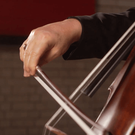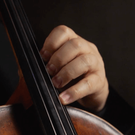Fundamentals
The closest you can get to 1-on-1 lessons with true masters teaching and explaining in great detail the fundamentals of their instrument
Cello Fundamentals with Ralph Kirshbaum teaches you in 18 structured video lessons how to develop your cello playing both in terms of skills and musicality. The class is split into lessons about the most important principles for the right and then the left hand. Totalling 3 hours, it’s the most in-depth guide to cello playing that covers everything from basics to advanced techniques.
LESSON PLAN

01 Intro
Ralph Kirshbaum explains the class outline and what to keep in mind about technique and musical expression

02 Holding the bow
Learn about controlling and balancing the ‘origin of life in the creative process’, the surprising importance of the little finger and a practical exercise

03 Sounding points and sound production
Ralph shares his holistic view of producing sound in balance and teaches how to apply weight and not tension for a great sound

04 Application of weight
Detailed demonstration of the principle of applying weight, a counterintuitive lesson and a secret to wonderful double stops

05 Oral pointillism
Ralph demonstrates what you can learn from pointillism to realize a great sound and recounts a remarkable experience

06 Beginning a note
Practical advice on where and how to start the beginning of a note - and how not to

07 Bow changes
How to avoid tension and insecurity through listening and remaining in control of motion

08 String crossing
Ralph demonstrates in music examples how get more room to mold the sound and shares exercises to improve your string crossing

09 Bow speed
Learn how to vary bow speed in different styles for more or less resonance and core
Try this chapter now!
10 Articulation
Get Ralph’s take on articulation to differentiate voices and express what you believe about the music

11 Spiccato
Learn about spiccato and the different techniques involved

12 Outro
Ralph sums up the ‘Ying’ of playing cello

13 Basic hand position
Get advice and exercises how to place the left hand on the string in a position of balance to move around more freely

14 Shifting positions
Learn how to well prepare for position shifts and the motions and timings to carry them out

15 Left Hand Articulation
Ralph demonstrates how to articulate to reach the centre of pitch, give life to sound and enforce rhythm

16 Vibrato
Learn Ralph’s take on vibrato, how to vary it, feel sure and never lose the centre of a pitch

17 Trilling
How to master the challenge of trilling and practice advice

18 Pizzicato & Outro
Dive into great examples of the different pizzicatos in music and how you can benefit from them
Reviews
I must say I have never before been exposed to quite as much artistic insight on music making in so short a time and it is wonderful that I can go back to the videos time and again, whenever I want. The Ralph Kirshbaum Cello Bundle seems to me a rare opportunity to learn what such an artist as the current holder of the Piatigorsky Chair at USC thinks and does technically and artistically and to see and hear it applied. The Fundamentals portion alone is well worth what I paid for the entire Cello Bundle. When having a lesson one usually gets the teacher's comments on the student's actions, sound, and interpretation, but not nearly so much of the teacher's insights as this video provides. His ideas about technique are very open minded: he is not at all parochial about how you hold your arm, fingers, or bow. Thus cellists from almost any pedagogical background can learn from what he says and demonstrates without much revision. I take issue with the way the Pizzicato segment was filmed - not enough right hand is shown - and the camera angle could/should be different for that segment. I think there is some weakness in the Vibrato segment. There is actually quite a lot of controversy about how vibrato is centered, and recent "scientific" measurements do seem to show it the fundamental tone is more centered than "at the top" of the range. Even we players who think we are vibrating up to the pitch seem to ignore the overshoot of the upper edge of the finger (I was one such player until I read the literature last week). Another important factor, that may not be apparent to someone who plays a Montagnana and whose students have cellos of Thornton School caliber - not all cellos respond that well to rather tame vibrato. And finally, on this subject: the way vibrato really works successfully is to engage the strongest overtones of the fundamental tones near the target pitch and what these overtones are, how strong they are is very dependent on an instrument's quality. A player who vibratos to get the desired sound (which Kirshbaum does and describes very beautifully) is thus at the mercy of the instrument's characteristics and has to adjust vibrato to match. I think it is helpful to know what is going on acoustically to create the desired effect. I am a happy customer!
These cello lessons exceeded my expectations. The photography was clear and practical, allowing me to see the full fingerboard or bow, as needed. I found Ralph Kirshbaum's ideas easy to apply in my own practice. He was never dogmatic, but he wasn't shy about offering his views on many of the basic techniques. I have a terrific "offline" teacher but these "online" lessons have already been very useful, as a supplement. I enjoyed the slower pace of these lessons -- compared, for example, with David Finckel's excellent online cello talks. Thank you for a very strong production!
More from Ralph Kirshbaum
Masterclasses
Learn hands-on advice on technique, sound and musical interpretation - exemplified through masterclasses of some of the most important and beautiful works.
Other Videos
Fundamentals
All left and right-hand fundamentals
Masterclasses
All 3 masterclasses
$74.99
Take all classesAll Play with a Pro Video Titles
With the Mega Video Bundle you get access to all video titles in the Play with a Pro Movie library, that's more than 150 hours HD Video material. Any future titles will be added for free to the Mega Bundle. Start learning today from the world's greatest artists and teachers and begin to feel the difference in your own playing.



